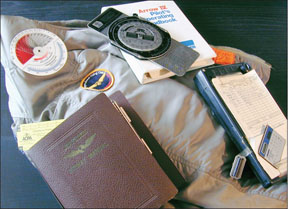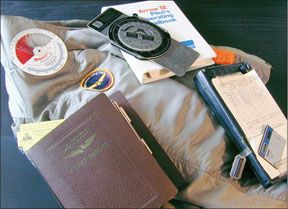
By Joseph E. (Jeb) Burnside
Playing the numbers game-striving to nail airspeeds, fuel consumption, ETAs, and takeoff and landing distances, can be one of the more satisfying parts of flying. For example, its gratifying to know we can hold 120 KIAS and the glideslope all the way to decision height and then slide the mains onto the runway. But sometimes, we just want to go fly without all the hassle. Sure, there must be sufficient fuel in the tanks and we still have to have something in the way of a plan before firewalling the throttle, but sometimes we can get by without a full-blown written flight plan by using some approximate numbers.
We dont need a calculator with six digits of precision-so what if were a minute or two late after an 800-mile trip?-or even an E-6B computer. We should be able to do most of this in our head.
Perhaps even more important, knowing a little basic math about flying can really help out in a pinch-like when something in the panel soils the bed and we have to limp home without our full bag of tricks. Lets try to put a few more tricks in that bag.
Non-Standard Days
Pilots are always wondering about performance: How fast can we cruise today, or how much runway will we need to take off? In addition to the airplanes weight and general condition-dragging brakes, soft cylinders, nicked props-the ambient temperature and pressure altitude figure prominently in how well an airplane performs on a given day. Fortunately, much of this is easy to calculate, and without resorting to detailed charts.
For example, the performance numbers in our airplanes paperwork are based on a so-called standard day, which someone long ago decided was 59 degrees F and 29.92 inches Hg at sea level. Thats great if youre flying from the beach, but for the rest of us, how do we determine whether its a standard day and compensate for any deviations?
Well, you probably know that ambient pressure drops off an average of one inch of mercury (Hg) for each thousand feet we climb, at least in the lower altitudes. Similarly, the standard temperature lapse rate as we ascend is 3.5 degrees F (or 2 degrees C, if you prefer). Once we know the pressure altitude-by setting the altimeter to 29.92 inches and reading the indicated altitude-its relatively simple to determine whether the current temperature is above or below standard: Multiply the pressure altitude-in thousands-by 3.5 and then subtract the result from 59.
So, if were at an airport with a 3000-foot pressure altitude, and we want to know the standard temperature, heres the math:
3 x 3.5 = 10.5
59 – 10.5 = 48.5
So, the standard temperature at 3000 feet is 48.5 degrees F.
Of course, once we know whether the ambient temperature is warmer or colder than standard, we can use basically the same procedure to compute density altitude. The basic rule of thumb is that density altitude increases or decreases by an average of 630 feet for every 10 degrees F of variation from standard. So, using the example above-the standard temperature at 3000 feet pressure altitude is 48.5 degrees F-lets assume the actual value displayed on the airplanes outside temperature gauge is 69 degrees F. Well round the difference between 48.5 and 69 to 20 degrees. Heres the math:
20 / 10 = 2
2 x 630 = 1260
3000 + 1260 = 4260
So, the density altitude at 3000 feet on a 69-degree F day is approximately 4260 feet.
Climbing
At many airports, an instrument departure procedure (DP) requires a certain minimum climb rate per mile until reaching a specified altitude. Thats all well and good, but my airplanes vertical speed indicator isnt calibrated in feet per mile. Is there a quick way to determine the minimum climb rate in feet per minute required to comply with the DP? You bet.
The basic formula is that the rate of climb in feet per minute equals the climb rate in feet per mile multiplied by the result of dividing the groundspeed by 60. So, lets presume the DP we want to fly requires a climb rate of 400 feet per nautical mile from the airports elevation of 3000 feet msl to an altitude of 7000 feet msl. During the climb, well average a groundspeed of 120 knots. (If you figure your groundspeed in miles per hour, youll need to convert it to knots for this calculation.) Will we make it?Heres the math:
120 / 60 = 2
2 x 400 = 800
Using this formula, well need to climb at 800 fpm from the airport elevation of 3000 feet msl to 7000 feet to comply with the DP. Not many normally aspirated singles can do that, at least at gross weight, so we may need to wait for some VFR weather or use a different DP. See the “More Performance” sidebar for information on which airspeed to use when trying to maintain your airplanes best rate of climb.
What about other climbs, when the terrain is much flatter, but we want to extract the most performance from the airplane? What should we do when dealing with headwinds or tailwinds in a climb?
The same basic rule we should employ while en route when compensating for wind should be applied here, too: Accelerate into a headwind and decelerate with a tailwind. But in the airplanes most of us fly, its often impossible to accelerate in a climb and see an acceptable rate-the excess speed and power necessary just isnt available.
So, to reduce the effects of a headwind on our climb and maximize our groundspeed, we should plan to use the highest airspeed producing an acceptable rate of climb. Of course, this is easiest when were VFR and theres no terrain we need to avoid.
With a tailwind, use your airplanes normal best-rate-of-climb speed and compensate for altitude by reducing it one percent per thousand feet (for most airplanes through medium twins).
Descending
Once weve nailed our climb performance and used some of the tips in the “Cruise Rules” sidebar to extract the best cruise performance, it soon will be time to descend for a landing. We can use rules of thumb to ensure we maximize our descent, too.
As I near my destination, one basic question Im always wrestling with is when to start down. I have a nice little box in the panel that computes vertical navigation parameters for me, but using it takes away all the fun.
For example, whether IFR or VFR, I try to use a 400-fpm descent because thats the most comfortable for me (and for my autopilots vertical speed feature). When the weather is VFR and Im not going to need to shoot an approach, I like to reach my destinations pattern altitude five miles out.This means I need to pick a point at which to start descending at 400 fpm that puts me level five miles out.
If I have any altitude at all in the cruise, Ill usually be doing around 180 knots over the ground in the descent. This math is easy, since 180 (groundspeed) means Im covering three nautical miles per minute. If Im at 9500 feet in cruise, and my destinations pattern altitude is 1500 feet msl, I need to lose 8000 feet. At 400 fpm, thats 20 minutes of descent; at 180 knots, Ill cover 60 nm in 20 minutes, so I need to start down 65 nm from my destination. Heres the math:
8000 (feet) / 400 (fpm) = 20
20 (min.) x 3 (nm/minute) = 60
I also need to add five nm for the distance from the airport at which I want to reach my target altitude.
Planning my descents like this allows me to use all that kinetic energy (altitude) I built up, manage the airplane more easily, keep the engine and its temperatures stabilized and fly more smoothly.
Putting It Together
Some basic rules of thumb for various operations can make your flying easier, more efficient and less haphazard-not to mention more professional.
Of course, there are a number of other rules we can employ and well try to explore them in a future article.
Also With This Article
“Cruise Rules”
“More Performance”
“True Airspeed”
“Emergencies”




